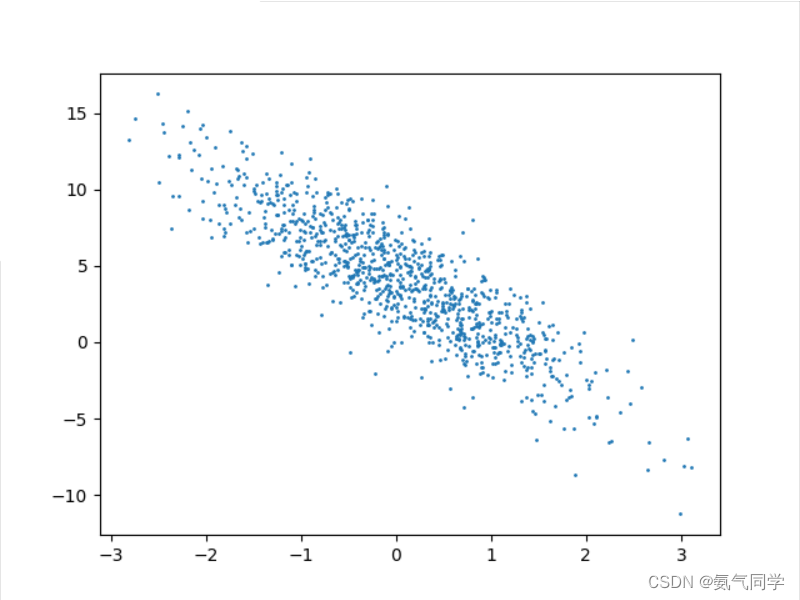一、生成数据集
def synthetic_data(w, b, num_examples):
"""Generate y = Xw + b + noise."""
X = torch.normal(0, 1, (num_examples, len(w)))
y = torch.matmul(X, w) + b
y += torch.normal(0, 0.01, y.shape)
return X, y.reshape((-1, 1))此时X是一个num_examples × len(w),均值为0,标准差为1的张量,y是num_examples × 1
的张量,再加上均值为1,标准差为0.01的噪声
true_w = torch.tensor([2, -3.4])
true_b = 4.2
features, labels = synthetic_data(true_w, true_b, 1000)将w = ([2, -3.4]), b = 4.2输入,数据量为1000,得到原始数据集,通过matplotlib绘制出来
plt.scatter(features[:, 1].detach().numpy(), labels.detach().numpy(), 1)
plt.show()
二、读取数据集
def data_iter(batch_size, features, labels):
"""Iterate through a dataset."""
num_examples = len(features)
indices = list(range(num_examples))
random.shuffle(indices) # The examples are read at random, in no particular order
for i in range(0, num_examples, batch_size):
batch_indices = torch.tensor(indices[i: min(i + batch_size, num_examples)])
yield features[batch_indices], labels[batch_indices]- batch_size: 每个批次的样本数量
- features: 特征数据,一个特征矩阵或张量
- labels: 标签数据,对应于每个样本的目标值或类别
首先,通过 len(features) 获取样本数量,并将索引存储在 indices 列表中
使用 random.shuffle(indices) 将索引列表随机打乱,以便以随机顺序读取样本
使用 range 函数遍历样本索引,步长为 batch_size,以获取每个批次的起始索引
对于每个批次的起始索引 i,使用 torch.tensor(indices[i: min(i + batch_size, num_examples)]) 获取批次对应的索引列表,并将其转换为 PyTorch 的张量
使用获取的批次索引,通过 features[batch_indices] 和 labels[batch_indices] 获取相应的特征和标签数据,使用 yield 关键字返回每个批次的特征和标签数据
设置批量大小为10,读取一组数据:
batch_size = 10
for X, y in data_iter(batch_size, features, labels):
print(X, '\n', y)
breaktensor([[-0.0696, 0.7543],
[-0.7112, 1.1201],
[ 0.3787, -0.1899],
[-0.4493, 0.6387],
[-0.0395, 1.6439],
[ 1.6767, 0.9483],
[-0.6776, 0.0829],
[ 0.1027, 1.4863],
[-0.3009, 0.3095],
[ 0.1412, 0.5425]])
tensor([[ 1.4887],
[-1.0235],
[ 5.6077],
[ 1.1209],
[-1.4830],
[ 4.3342],
[ 2.5570],
[-0.6442],
[ 2.5390],
[ 2.6399]])
三、初始化模型参数
w = torch.normal(0, 0.01, size=(2, 1), requires_grad=True)
b = torch.zeros(1, requires_grad=True)四、定义模型
def linreg(X, w, b):
"""The linear regression model."""
return torch.matmul(X, w) + b线性回归模型的预测值是通过将输入特征数据 X 与权重参数 w 相乘,再加上偏置参数 b 来计算的
五、定义损失函数
def squared_loss(y_hat, y):
"""Squared loss."""
return (y_hat - y.reshape(y_hat.shape)) ** 2 / 2使用均方损失函数,计算预测值和真是值之间的差距
六、定义优化算法
def sgd(params, lr, batch_size):
"""Minibatch stochastic gradient descent."""
with torch.no_grad():
for param in params:
param -= lr * param.grad / batch_size
param.grad.zero_()小批量随机梯度下降以最小化损失函数,对于每个需要更新的参数 param,执行以下步骤:
- 计算参数的梯度,即
param.grad。 - 将参数更新的量计算为
lr * param.grad / batch_size,其中lr是学习率,param.grad是梯度,batch_size是小批量样本的数量。 - 将参数减去更新的量,即
param -= lr * param.grad / batch_size,从而更新参数。 - 调用
param.grad.zero_()将参数的梯度清零,以便下一次迭代计算新的梯度
七、开始训练
设置参数
lr = 0.03 # Learning rate
num_epochs = 3 # Number of iterations
net = linreg # Our fancy linear model
loss = squared_loss # 0.5 (y-y')^2for epoch in range(num_epochs):
for X, y in data_iter(batch_size, features, labels):
l = loss(net(X, w, b), y)
# Compute gradient on l with respect to [w,b]
l.sum().backward()
sgd([w, b], lr, batch_size) # Update parameters using their gradient
with torch.no_grad():
train_l = loss(net(features, w, b), labels)
print(f'epoch {epoch + 1}, loss {float(train_l.mean()):f}')- 使用
range(num_epochs)迭代训练指定数量的 epochs。 - 在每个 epoch 中,使用
data_iter函数按批次遍历数据集,并获取特征X和标签y。 - 使用模型
net、权重参数w和偏置参数b来计算预测值,并计算预测值与真实值之间的损失l。 - 通过调用
l.sum().backward()计算损失l对于参数[w, b]的梯度。 - 使用
sgd([w, b], lr, batch_size)调用小批量随机梯度下降函数,更新参数[w, b]。 - 在每个 epoch 结束时,使用
torch.no_grad()上下文管理器,计算整个训练集上的损失train_l,以评估模型的训练效果。 - 打印当前 epoch 的序号和损失值。
通过这个训练循环,模型在每个 epoch 中都会遍历整个数据集,并使用小批量样本计算梯度和更新参数。通过不断迭代优化模型的参数,损失值将逐渐减小,模型对训练数据的拟合效果将逐渐提升。
print(f'estimating w: {w.reshape(true_w.shape)}')
print(f'estimating b: {b}')
print(f'error in estimating w: {true_w - w.reshape(true_w.shape)}')
print(f'error in estimating b: {true_b - b}')最后输出预测的参数值以及与真实值的误差:
estimating w: tensor([ 1.9997, -3.3996], grad_fn=<ReshapeAliasBackward0>)
estimating b: tensor([4.1995], requires_grad=True)
error in estimating w: tensor([ 0.0003, -0.0004], grad_fn=<SubBackward0>)
error in estimating b: tensor([0.0005], grad_fn=<RsubBackward1>)
八、完整代码
import torch
import random
import matplotlib.pyplot as plt
def synthetic_data(w, b, num_examples):
"""Generate y = Xw + b + noise."""
X = torch.normal(0, 1, (num_examples, len(w))) # X.shape = (num_examples, len(w))
y = torch.matmul(X, w) + b # y.shape = (num_examples, 1)
y += torch.normal(0, 0.01, y.shape) # Add noise
return X, y.reshape((-1, 1)) # y.shape = (num_examples, 1)
true_w = torch.tensor([2, -3.4])
true_b = 4.2
features, labels = synthetic_data(true_w, true_b, 1000)
plt.scatter(features[:, 1].detach().numpy(), labels.detach().numpy(), 1)
plt.show()
def data_iter(batch_size, features, labels):
"""Iterate through a dataset."""
num_examples = len(features)
indices = list(range(num_examples))
random.shuffle(indices) # The examples are read at random, in no particular order
for i in range(0, num_examples, batch_size):
batch_indices = torch.tensor(indices[i: min(i + batch_size, num_examples)])
yield features[batch_indices], labels[batch_indices]
batch_size = 10
for X, y in data_iter(batch_size, features, labels):
print(X, '\n', y)
break
w = torch.normal(0, 0.01, size=(2, 1), requires_grad=True)
b = torch.zeros(1, requires_grad=True)
def linreg(X, w, b):
"""The linear regression model."""
return torch.matmul(X, w) + b
def squared_loss(y_hat, y):
"""Squared loss."""
return (y_hat - y.reshape(y_hat.shape)) ** 2 / 2
def sgd(params, lr, batch_size):
"""Minibatch stochastic gradient descent."""
with torch.no_grad():
for param in params:
param -= lr * param.grad / batch_size
param.grad.zero_()
lr = 0.03 # Learning rate
num_epochs = 3 # Number of iterations
net = linreg # Our fancy linear model
loss = squared_loss # 0.5 (y-y')^2
for epoch in range(num_epochs):
for X, y in data_iter(batch_size, features, labels):
l = loss(net(X, w, b), y)
# Compute gradient on l with respect to [w,b]
l.sum().backward()
sgd([w, b], lr, batch_size) # Update parameters using their gradient
with torch.no_grad():
train_l = loss(net(features, w, b), labels)
print(f'epoch {epoch + 1}, loss {float(train_l.mean()):f}')
print(f'estimating w: {w.reshape(true_w.shape)}')
print(f'estimating b: {b}')
print(f'error in estimating w: {true_w - w.reshape(true_w.shape)}')
print(f'error in estimating b: {true_b - b}')




















 20万+
20万+











 被折叠的 条评论
为什么被折叠?
被折叠的 条评论
为什么被折叠?








